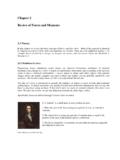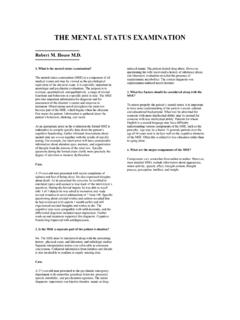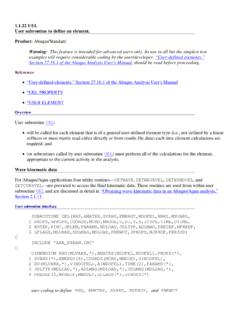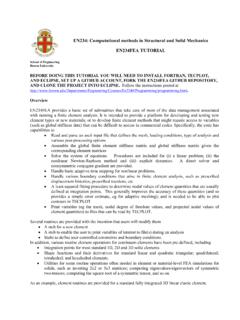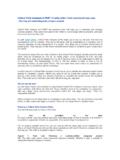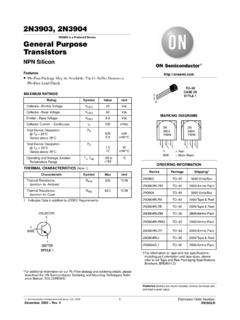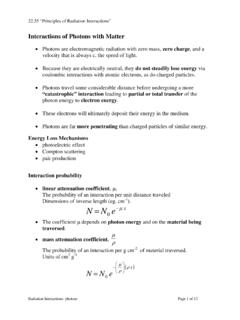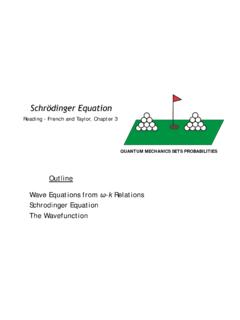Transcription of Spontaneous and stimulated processes Einstein A and B ...
1 2. Laser physics - basicsSpontaneous and stimulated processesEinstein A and B coefficientsRate equation analysisGain saturationWhat is a laser?LASER: Light Amplification by stimulated Emission of Radiation"light" could mean anything from microwaves to x-raysEssential elements:1. A laser medium - a collection of atoms, molecules, A pumping process - puts energy into the laser medium3. Optical feedback - provides a mechanism for the light to interact (possibly many times) with the laser mediumground stateexcited stateQuantum energy levelsAbsorption: promotes an electron from the ground to the excited stateEmission: drops the electron back to the ground stateConservation of energy : Eexcited-Eground= Ephoton" Spontaneous emission" - the decay of an excited state to the ground state with the corresponding emission of a photonThe two-level atomThree things can occur Promotes molecule to a higher energy state Decreases the number of photons Molecule drops from a high energy state to a lower state Increases the number of photons This is the only one that does NOT require a photon in the initial state Molecule drops from a high energy state to a lower state The presence of one photon stimulates the emission of a second oneAbsorption Spontaneous Emission stimulated EmissionAn atom in the excited state can relax to the ground state by: Spontaneous emission: rate is rad any of a variety of non-radiative pathways: rate = nrAll of these processes are single-atom processes .
2 Each atom acts independently of all the , evolution of the excited state population only depends on the number of atoms in the excited state: 10= total Spontaneous relaxation rate from state 1 to state 0 Relaxation of the two-level atom10 eradenreedNNN Ndt " stimulated transitions" - a collective processinvolving many two-level atomsstimulated absorption: light induces a transition from 0 to 1stimulated emission: light induces a transition from 1 to 0In the emission process, the emitted photon is identicalto the photon that caused the emission! stimulated transitions: likelihood depends on the number of photons aroundA collection of two-level atomsRayleigh-Jeans law (circa 1900): energy density of a radiation field u( ) = 8 2kT/c3 Total energy radiated from a black body: ud the "ultraviolet catastrophe"Solution: quantum mechanicsTime-dependent perturbation theoryAs a result of a perturbation h(t), a system in quantum state 1 makes a transition to quantum state 2 with probability given by: 212'1221'' tiE tPehtdtHow did it all begin?
3 2121: NotationE Note: the units of this expression are correct. Strictly speaking, u( ) is an energy density per unit bandwidth, such that the integral gives an answer with units of energy /volume. ud Key example: suppose we subject a two-level system, initially in state 1, to a harmonic perturbation, of the form: 0002sin0 thtAtt 2122'''01220' titititAPeeedt Transition probability to state 2 is: 222102221sin/ 24 tA Note that 1221 PPAbsorption and stimulated emission are equally likely! 21212/2/222121022121sin/ 2sin/ 24 ititetetA Harmonic perturbation(and suppose that the frequency of the perturbation, , is close to 21)RWANote: this is the same as radQuantum mechanics says that these two coefficients must be equal!Consider a radiation field and a collection of two-level systems, in thermal equilibrium with each emission probability:proportional to the number of atoms in upper state N2, and also to the number of photonsspontaneous emission probability:proportional to N2, but does not depend on the photon density!
4 2122 WANBuN stimulated absorption probability:proportional to the number of atoms in lower state N1, and also to the number of photonsspontaneous absorption:there is no such thing 121 WBuN But: in thermal equilibrium, the upward and downward transition rates must balance: 1221 WWEinstein A and B coefficientsEquate these two rates: 12 ABuNNBu But Boltzmann's Law tells us that(in equilibrium) 2112 EEkTNeN Recognizing that E2 E1= h , we solve for u( ): 1hkTABue This must correspond to the Rayleigh-Jeans result in the classical limit (h 0), which implies:338 AhBc Einstein A and B coefficientsSince A = rad, we can now solve for B also:338 radcBh Also has units of energy density per unit bandwidthBose- Einstein distribution 212221 WANBuNBANuA Transition ratesOur expression for the downward transition rate is now: 1 hkTABue 212111 hkTWANe But sincewe therefore haveIn other words, W21is proportional to: 1 + the number of photons.
5 121111 hkTWBuNANe It is easy to see that the upward transition rate, W12, is proportional to the number of photons:gestimulatedspontaneousspontaneo us emission:proportional to initial state populationstimulated transitions:proportional to initial state populationproportional to photon density npthe same for upwards, downwards transitionsNote: the constant Kis simply given by h B, where B is the Einstein B coefficientRate equation analysis ePPgegeedKNdNNnKntN eegePgedNNKnN Ndt gdNdtemitted photons go in all directionsemitted photons go only into the direction of the incident lightNumber of photons grows exponentiallyif Ne> NgA LASER!Rate equation analysis, continuedSo, photon number varies according to: PPg ePdnKn NNKnNdt eegePgedNNKnN Ndt Population inversion is impossible in inversion is impossible in equation analysis, part 3In thermal equilibrium: EkTeggNeN NIn a steady-state situation: 0 eegePgedNNKnN Ndt PeggegPKnNNNKn Non-radiativedecayNon-radiativedecayPump Four-level system1032 Steps1and2:Combine to give an effectivepumping rate for level 2:RpStep3: stimulated transitions due tonpspontaneous decay rate: 21 Lasing transitionStep4: Spontaneous decay rate: 10ppRR N 110N 110NN 221221pNNKn 21)(pNNKn +21)(So how do you make a laser?
6 210 dNdtdNdtdNdtSteady-state solution:A necessary condition for lasingPopulation inversion ( , N < 0) is assuredif 10> 21(even if np= 0, and even if Rpis small)Other necessary conditions: a resonant cavity - provides feedback net gain per round trip > net loss per round trip - threshold The four-level model2110121021 PPRNN NKn N0 population inversion when 2> 1 small signal inversion is proportional to the pump rate inversion level drops when Wsig> 21 the characteristic intensity for this effect is independent of pump rate Rp1/ 21 N/ N0"gain saturation"Saturation in the four-level atom21101021 PPRNKn 211021 102111 PsigRW Note: Wsigis proportional to nPand therefore to the intensity of the light in the medium. Thus, we can define a saturation intensityIsatsuch that:21 sigsatWII
